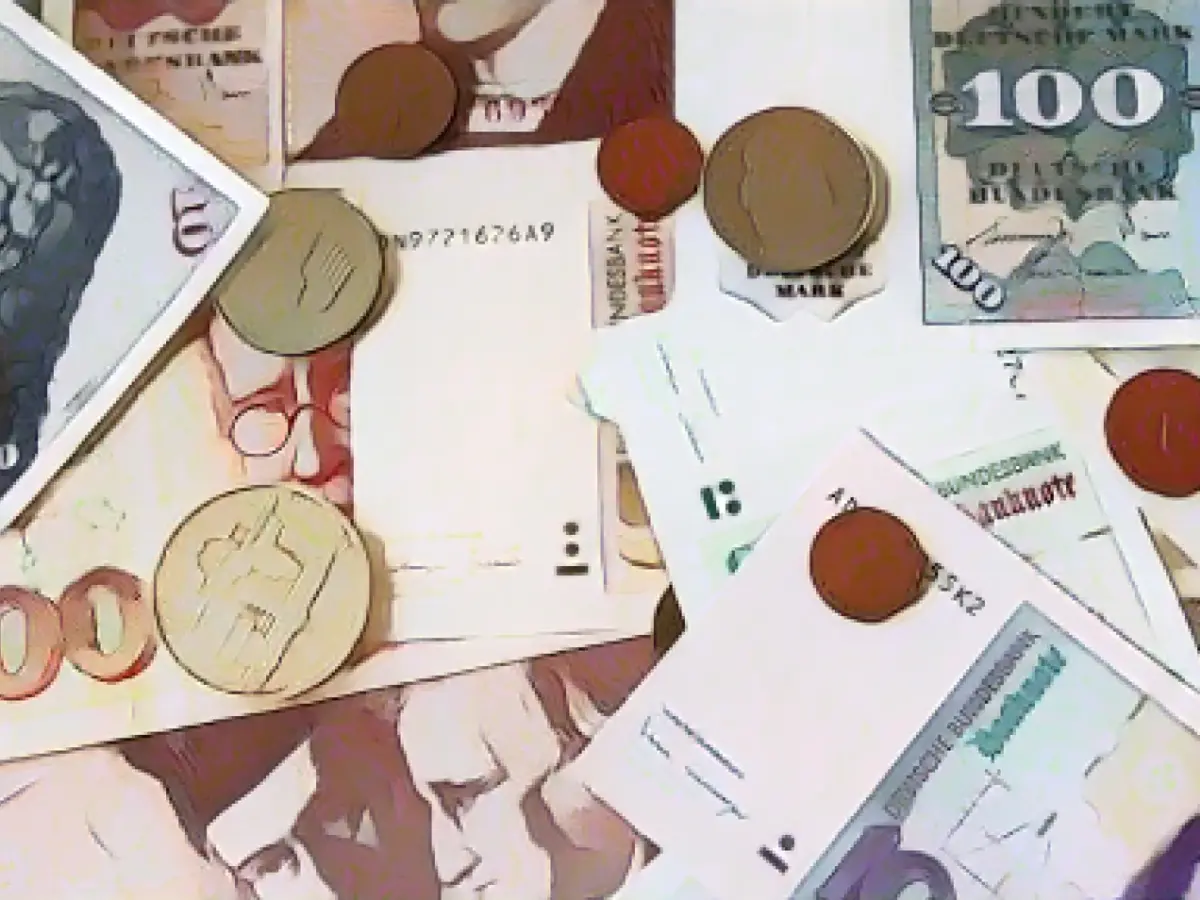German Currency Swap: 10 Million Deutschmarks Exchanged in North Rhine-Westphalia in 2023
In a throwback to the past, Deutschmark coins and bills have found a niche in modern-day collections and accessories, resulting in a surprising exchange event in 2023. In North Rhine-Westphalia, citizens exchanged over 9.8 million Deutschmarks for euros, outpacing the 2022 count of 8.3 million. This swap was significantly higher than the yearly total in Bavaria.
The Deutsche Bundesbank reported a nationwide exchange tally of 53 million Deutschmarks (equivalent to 27 million euros) between January and November 2023. This resurgence in annual exchanges marks the second increase in a row, raising questions about the longevity of this tossed-aside currency.
Balz, a spokesperson for the Bundesbank, speculates that the surge in exchanges likely stems from estate clearings, where the remnants of inherited homes and apartments often yield forgotten Deutschmarks. The Deutsche Mark's continued existence in some hidden stashes and collector's hands ensures that a portion of these relics will never undergo the conversion process.
Despite the Euro's widespread use since its introduction at the turn of the millennium, Deutsche Marks remain unclaimed in Germany. Boasting a value of nearly 6.24 billion euros at the end of November 2023, the significant amount of outdated currency is considered "legacy" property by Deutsche Bundesbank. When the Euro officially took the place of the Deutsche Mark in 2001, there were 162 billion marks in circulation.
The Bundesbank custodially manages the exchange process of Deutschmarks for euros by permitting citizens to exchange their Deutschmarks for free at any of its 31 branches or by post through the Mainz branch. The exchange rate, set at 1.95583 Deutschmarks per Euro, remains unaffected by inflation or economic fluctuations.
Germany is one of only six countries in the Eurozone that supports unlimited, no-cost exchanges of Deutsche Marks for euros. A testament to its long-term popularity, this unique exchange policy continues to attract users 22 years after the Deutsche Mark's official demise.
Fun Fact:
The longest-lasting banknote (27.2 years) ever to be issued in the Federal Republic of Germany was a 20-Deutschemark note, which remained in circulation from 1964 until 1991. In contrast, the replacement 20-Euro note has been in circulation since 2002.
Back to the topic:
- While officially phased out over two decades ago, Deutschmarks maintain a presence in the fashion and collectibles world as nostalgic accessories or pieces of historical significance.
- The Euro's debut at the turn of the century in 2001 brought the Deutsche Mark to an end as Germany's primary currency. However, pockets of D-Mark still circulate in some buildings and cities, including North Rhine-Westphalia.
- Germany joins only five other countries in the Eurozone by permitting unlimited, no-cost exchanges of Deutsche Marks for euros on behalf of the Bundesbank.
- An intriguing uptick in annual exchanges continues, despite a decade-long decrease in Deutsche Mark swaps since 2010.
- Despite demonstrating a higher exchange value in 2023, Bavaria fell behind North Rhine-Westphalia in total Deutsche Marks exchanged for euros, with over 10.28 million Deutschmarks handed over.
Source:
Enrichment Data:
Departing from the original article, it's essential to clarify that, despite the misleading headline, the Deutsche Mark is no longer a legal tender in Germany or any other country within the Eurozone. The Bundesbank has since replaced the Deutsche Mark with the Euro, making any Deutsche Mark circulating in the country a historical relic.
Given that the Deutsche Mark is no longer in circulation, it's not accurate to say that there are billions worth of these banknotes and coins still uncirculated. The exchange of Deutschmarks for euros does not take place, and the total value of any remaining Deutsche Marks does not impact the country's economy or monetary system. It's just historical collectibles or memorabilia.
Rewritten Article:
German Currency Swap: 10 Million Deutschmarks Exchanged in North Rhine-Westphalia in 2023
In a peculiar turn of events, Deutschmark bills and coins have found their way into the modern-day collectibles and fashion world, resulting in an unexpected exchange event in 2023. In North Rhine-Westphalia, citizens exchanged over 9.8 million Deutschmarks for euros, surpassing the 2022 count of 8.3 million. This swap was significantly higher than the yearly total in Bavaria.
The Deutsche Bundesbank reported a nationwide exchange tally of 53 million Deutschmarks (equivalent to 27 million euros) between January and November 2023. This resurgence in annual exchanges marks the second increase in a row, raising questions about the Deutsche Mark's remnants tucked away in hidden corners of Germany.
Balz, a spokesperson for the Bundesbank, speculates that the surge in exchanges likely stems from estate clearings, where the remnants of inherited homes and apartments often yield forgotten Deutschmarks. The Deutsch Mark's continued existence in some hidden stashes and collector's hands ensures that a portion of these relics will never undergo the conversion process.
The Bundesbank custodially manages the exchange process of Deutschmarks for euros by permitting citizens to exchange their Deutschmarks for free at any of its 31 branches or by post through the Mainz branch. The exchange rate, set at 1.95583 Deutschmarks per Euro, remains unaffected by inflation or economic fluctuations.
Euro, introduced at the turn of the millennium, is now the primary currency in use in Germany, while the Deutsche Mark remains a historical relic. Despite the EUR's widespread use, Deutsche Marks still circulate in some corners of the country, although any exchange for Euros is purely symbolic and has no practical impact on the economy.
Germany is one of only six countries in the Eurozone that supports unlimited, no-cost exchanges of Deutsche Marks for euros; a testament to its long-term popularity, this unique exchange policy continues to attract users 22 years after the Deutsche Mark's official demise.
Fun Fact:
The longest-lasting banknote (27.2 years) ever to be issued in the Federal Republic of Germany was a 20-Deutschemark note, which remained in circulation from 1964 until 1991. In contrast, the replacement 20-Euro note has been in circulation since 2002.
Back to the topic:
- While officially phased out over two decades ago, Deutschmarks maintain a presence in the fashion and collectibles world as nostalgic accessories or pieces of historical significance.
- The Euro's debut at the turn of the century in 2002 brought the Deutsche Mark to an end as Germany's primary currency. However, pockets of D-Mark still circulate in some buildings and cities, including North Rhine-Westphalia.
- Germany joins only five other countries in the Eurozone by permitting unlimited, no-cost exchanges of Deutsche Marks for euros on behalf of the Bundesbank.
- An intriguing uptick in annual exchanges continues, despite a decade-long decrease in Deutsche Mark swaps since 2010.
- Despite demonstrating a higher exchange value in 2023, Bavaria fell behind North Rhine-Westphalia in total Deutsche Marks exchanged for euros, with over 10.28 million Deutschmarks handed over.
Source:








